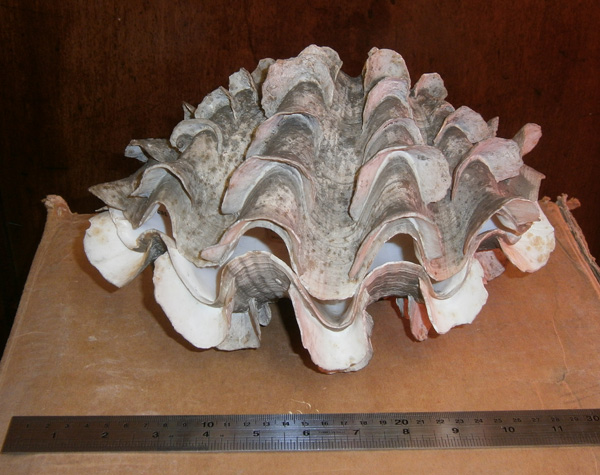1855
Giant Clam from Singapore
The Fluted Giant Clam - Tridacna squamosa - was once an abundant feature of the Indo-Pacific region and an essential resource for Pacific Islanders, but it was also historically revered as a ‘killer clam’. Sadly, today these clams have been reduced to cripplingly low numbers in the wild by human activity.
Description
This specimen consists of two separated halves called valves, measuring 26cm long, 17cm wide and 16cm high. Each valve has six ridges running from the bottom to the top of each valve, giving the outer lip of each valve a wavy appearance. There are several raised shelves (called scutes) projecting from each ridge, providing a frilly appearance to external surface. The inner surface of each valve is smooth and concave.

The original RDS specimen labels read:
“Genus: Tridacna, Species: Squamosa, Lm.; Locality: Singapore; Donor: Sir Wm. Jeffcott”
Clams and People
The Fluted Giant Clam is a bivalve mollusc, endemic to reefs of the Indo-Pacific region, including the waters around Singapore. These clams are an important feature in their reef habitat as they provide food, substrate for attachment, and shelter for other organisms.
Pacific Islanders have long since used these animals as a source of food. Clam shells were also converted into various household items, such as doorstops, bowls, feed troughs and soap dishes. In addition, historically in the Solomon Islands, clam shells were converted to a ‘disc money’ form of currency for barter. To date, the Fluted Giant Clam is still highly sought after as a culinary delicacy, their shells for ornamentation, and entire live animals for aquarium population.
Early literature about these animals considered them ‘killer clams’ due to their large size; capable of drowning a diver by snapping shut and trapping them. However, this is not the case: unlike other giant clam species the Fluted Giant Clam is capable of completely closing its valves together, but this is a slow process, deployed as a defence mechanism against predators; it poses no real threat to divers.
Life for the Giant Clam
Adult Fluted Giant Clams are sessile organisms, unable to move from the substrate to which they have attached themselves. The clams have remarkable strategies to help them survive their sedentary lifestyle. The clams have two ways of feeding: they can directly ingest food by siphoning it from the surrounding water; they also get their energy requirements via a symbiotic relationship with zooxanthellae (microscopic algae) that live in their tissue; producing food for both the clam and themselves via photosynthesis. The zooxanthellae in turn receive protection from predators inside the clam.
Fluted Giant Clams are hermaphroditic, increasing their reproductive success in areas populated by few individuals. Shell scutes (shelf-like projections on the outer shell) are another development which help the Fluted Giant Clam to survive, especially as juveniles. The scutes increase the overall size of the clam, reducing the number of predators (e.g. crabs) which would be able to crush and eat the clam.

Wild Clams in Singapore
Currently the Fluted Giant Clam has been recorded as being in extremely low numbers in Singapore and it is specifically listed as ‘endangered’ in the Singapore Red Data Book, with three other giant clam species having already totally disappeared from the reefs around Singapore. This reduction in clam numbers is due to over- exploitation, loss of habitat, and a reduction in water quality due to increased coastal development and dredging of shipping lanes.
In an effort to preserve existing wild populations of Fluted Giant Clams around Singapore, conservation strategies are in place. Also, there have been positive results from research done to investigate the viability of restocking wild populations with individuals produced through mariculture, including reintroducing other species which are currently locally extinct.
Learn more
Currently this specimen is not on public display as it is part of the museum’s reserve collections, but if you would like to see other examples of marine bivalves you can do so by visiting the Irish Fauna exhibition on the ground floor of the National Museum of Ireland - Natural History.
References
- Neo, M. L., & Todd, P.A. (2012). Giant clams (Mollusca: Bivalvia: Tridacninae) in Singapore: History, research and conservation. Raffles B Zool, 25, 67-78.
- Han. L., Todd, P.A., Chou, L.M., Von Bing, Y., Sivaloganathan, B. (2008).The defensive role of scutes in juvenile fluted giant clams (Tridacna squamosa).Journal of Experimental Marine Biology and Ecology, 359, 77-83.
- Dolgov, L.V. (1992). Sexual structure of a Tridacna Squamosa population: relative advantages of sequential and simultaneous hermaphroditism. Journal of Molluscan Studies. 58, 21-27.
- Guest, J.R, Todd, P.A., Goh, E., Sivaloganathan, B., Reddy, K.P. (2008). Can giant clam (Tridacna squamosa) populations be restored on Singapore's heavily impacted coral reefs?. Aquatic Conservation: Marine and Freshwater Ecosystems. 18, 570-579.
Location:
Giant Clam from Singapore is located at:
In Storage
Previous artefact:
A Fossil Crinoid: Dimerocrinus Decadactylus
Next artefact:
